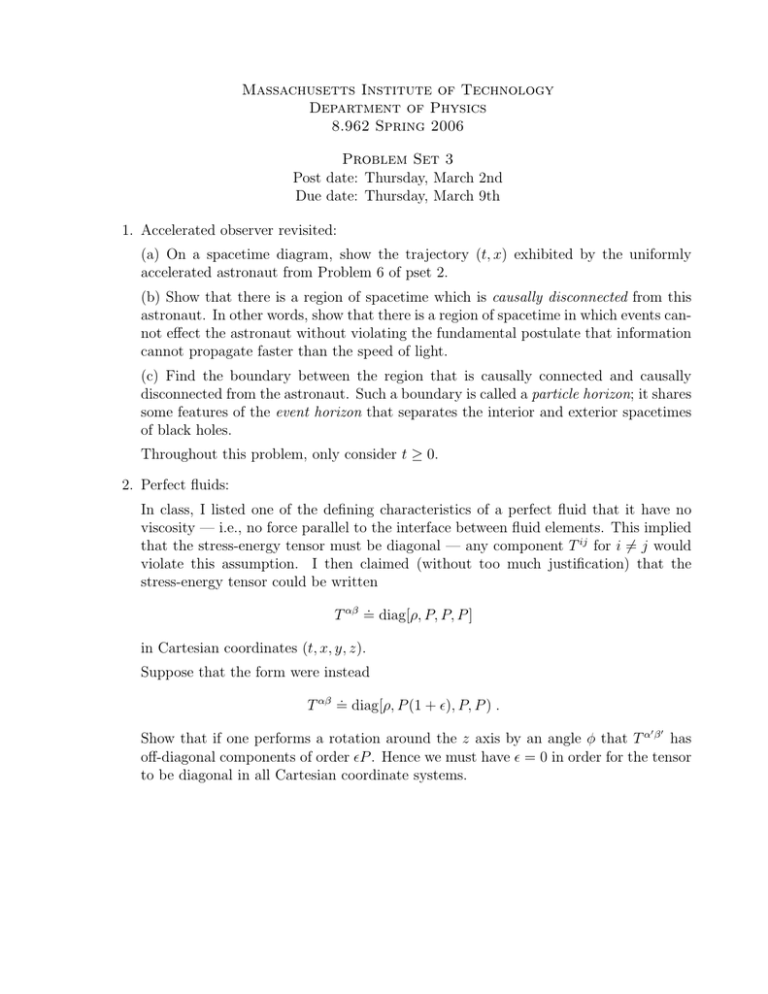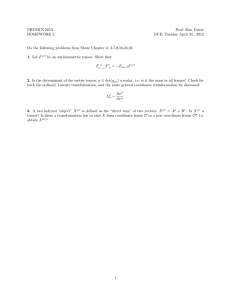Document 13650321
advertisement

Massachusetts Institute of Technology Department of Physics 8.962 Spring 2006 Problem Set 3 Post date: Thursday, March 2nd Due date: Thursday, March 9th 1. Accelerated observer revisited: (a) On a spacetime diagram, show the trajectory (t, x) exhibited by the uniformly accelerated astronaut from Problem 6 of pset 2. (b) Show that there is a region of spacetime which is causally disconnected from this astronaut. In other words, show that there is a region of spacetime in which events can­ not effect the astronaut without violating the fundamental postulate that information cannot propagate faster than the speed of light. (c) Find the boundary between the region that is causally connected and causally disconnected from the astronaut. Such a boundary is called a particle horizon; it shares some features of the event horizon that separates the interior and exterior spacetimes of black holes. Throughout this problem, only consider t ≥ 0. 2. Perfect fluids: In class, I listed one of the defining characteristics of a perfect fluid that it have no viscosity — i.e., no force parallel to the interface between fluid elements. This implied that the stress-energy tensor must be diagonal — any component T ij for i = � j would violate this assumption. I then claimed (without too much justification) that the stress-energy tensor could be written . T αβ = diag[ρ, P, P, P ] in Cartesian coordinates (t, x, y, z). Suppose that the form were instead . T αβ = diag[ρ, P (1 + �), P, P ) . � � Show that if one performs a rotation around the z axis by an angle φ that T α β has off-diagonal components of order �P . Hence we must have � = 0 in order for the tensor to be diagonal in all Cartesian coordinate systems. 3. “3+1” split of the electromagnetic field: � interacting with an electromagnetic field F measures An observer with 4-velocity U � � � in their instantaneous local inertial reference electric and magnetic fields EU� and B U � ). These fields are 4-vectors with frame (that is, in an orthonormal basis with �e0̂ = U components 1 BUα� = − �αβγδ Uβ Fγδ . 2 EUα� = F αβ Uβ , � � and B � � lie orthogonal to observer’s worldline. Thus, they are spatial (a) Show that E U U vectors according to the observer, living entirely in that observer’s hypersurface of simultaneity. (Hint: recall the projection tensor defined in Pset 1.) (b) Show that the field tensor can be reconstructed from the observer’s 4-velocity and the electric and magnetic fields they measure via the following tensor equation (valid for any basis): F αβ = U α EUβ� − EUα� U β + �αβ γδ U γ BUδ� . � � The identity �αβρσ �µνρσ = 2 δ α ν δ β µ − δ α µ δ β ν may prove useful. (c) The wedge product between two vectors is defined as �∧B � =A �⊗B � −B � ⊗A �. A The Hodge dual of a (0, 2) tensor is defined as ∗ 1 Cµν = �αβ µν Cαβ . 2 Show that the field tensor may be written � � ∧E �� + b∗ U � ∧B �� F = aU U U � . What are the values of the real constants a and b? 4. Transformation of Christoffel symbols: (a) Show that, under a coordinate transformation, the components of the Christoffel symbol transform as follows: � � Γα β � γ � = � ∂xα ∂xβ ∂xγ α ∂ 2 xα ∂xβ ∂xγ Γ − βγ ∂xα ∂xβ � ∂xγ � ∂xβ ∂xγ ∂xβ � ∂xγ � Do this by considering the form of the Christoffel symbol in terms of derivatives of the metric. (b) Show that, using this rule, the components of the covariant derivative of a vector transform as tensors should: � � �α� Aβ = ∂xα ∂xβ �α Aβ . � α β ∂x ∂x 5. Carroll: Chapter 3, Problem 2. In this problem, define the curl via (curl V� )i = �i jk �j Vk . 6. Carroll: Chapter 3, Problem 3. 7. Prove the following connection identities: (a) ∂λ gµν = Γµνλ + Γνµλ . (b) gµκ ∂λ g κν = −g κν ∂λ gµκ . (c) ∂λ g µν = −Γµ λκ g κν − Γν λκ g κµ The next three parts rely on an identity I will prove on either Thursday March 2nd or on Tuesday March 7th. The quantity g is the determinant of the metric gµν . � � � � (d) �ν Aµ ν = |g|−1/2 ∂ν |g|1/2 Aµ ν − Γλ νµ Aλ ν in a coordinate basis. (e) �ν F µν = |g|−1/2 ∂ν |g|1/2 F µν in a coordinate basis, if F µν is antisymmetric. � � (f) �S ≡ g µν �µ �ν S = |g|−1/2 ∂µ |g|1/2 g µν ∂ν S in a coordinate basis. (S is a scalar function.)




